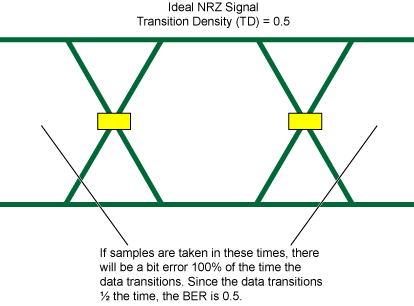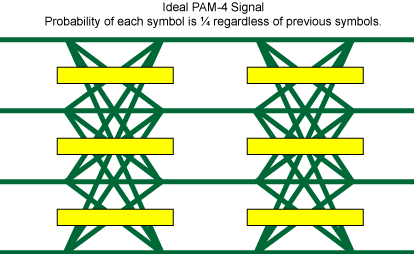Eye Width Result
The Jitter mode Eye Width measurement measures the width of each eye. The results are placed in the following results table:
- Jitter table for NRZ signals.
- Eye table for PAM4 signals.
Use the Advanced tab of the Jitter Mode Measurement Setup dialog to specify that the measurement be based on probability or Symbol Error Ratio (SER). The eye width measurements specified in the latest PAM4 standards are made at probabilities instead of Symbol Error Rate (SER).
When measuring PAM4 waveforms, this measurement is the recommended and fastest Eye Width measurement when compared to Eye Mode's Eye Width measurement. Eye mode's Eye Width measurement on PAM4 waveforms can be used as a quick comparative check between signals. For example, when tuning pre-emphasis on a transmitter. In the following situations, you may want to use Eye Mode's measurement:
- For longer patterns, such as PRBS31Q, as Eye mode does not require pattern lock.
- When data is random or when measuring multiple waveforms at the same time.
Probability vs. SER (NRZ signals)
To make an eye width measurement at a probability, we make a Cumulative Distribution Function (CDF) for the left and right eye edges at our sampling threshold. These CDFs are the probability that an edge passes through the sampling threshold anywhere between this x location and the eye center. The probabilities range from 0 at the eye center to 1 outside the eye. However the edge regions only occur when the data transitions (half the time for this example), so the CDFs need to be scaled by half to calculate the eye width at a BER.
For example, if we are interested in the eye width at a probability of 10-6: the equivalent BER is TD * 10-6 (0.5 * 10-6).

Probability vs. SER (PAM4 signals)
Counting the transitions, we can see there are 12 different types of symbol transitions in a PAM4 signal (0/1, 0/2, etc.). There are also four sequences where the symbol doesn’t transition (0/0, 1/1, 2/2, and 3/3.).

Only transitions that pass through a particular eye will have an effect on that eye’s width. Therefore, the Transition Density (TD) through our eye of interest will determine the difference between eye width at a probability and at an SER.
For this ideal PAM4 signal:
- 6 symbol transitions pass through the top eye: 6 transitions / 16 total sequences = 0.375 transition density.
- 8 symbol transitions pass through the middle eye: 8 transitions / 16 total sequences = 0.5 transition density.
- 6 symbol transitions pass through the bottom eye: 6 transitions / 16 total sequences = 0.375 transition density.
Using the conversion from earlier we can find the SER that matches an eye width probability by multiplying the probability by the transition density.
For example, if we are interested in the eye width at a probability of 10-6 for all eyes: the equivalent SER is TD * 10-6 (0.375 * 10-6, 0.5 * 10-6, 0.375 * 10-6 for Eye 0/1, 1/2, and 2/3 respectively).
You can measure Eye Width on patterns longer than PRBS16, such as PRBS31, using Advanced Eye Analysis.
More Information
SCPI Command
:MEASure:JITTer:EWIDth